On kids’ side against sex traffickers
September 18, 2013
Michelle Guymon understands why people pass by the children on the boulevards, looking but not really seeing youthful lives shrouded in peril and despair.
For years, she did it herself.
“I’ve seen young girls on the side of the road,” said Guymon, who joined the county’s Probation Department in 1989. “There comes a time in your life when you don’t even pay attention to that anymore because you’re on the phone, you’re on your way to work, you’re focused on the street lights…You just drive by stuff.”
She’s not just driving by anymore. Three weeks ago, Guymon was named the first director of the county’s Domestic Minor Sex Trafficking Project. She’s determined to help the system—and the public—see the grim reality of underage girls, some as young as 10 years old, being victimized by the sex trade.
Guymon, 52, said her own awakening was a long time coming. For years, like others in the criminal justice system, she had taken a dim view of those girls by the side of the road.
“I had looked at these young women as teenage prostitutes, and this was just the crime they committed, like this girl over here committed a crime for robbery,” she says. “And I remember having judgments about them, that this was their fault, this was their choice.”
An unexpected assignment to a subcommittee on underage sex trafficking in 2010 shook her world view. At first, she was puzzled by the terminology being used, assuming that “trafficking” was something that just happened to kids from faraway countries.
When she attended the first meeting, she discovered that everything she thought she knew was wrong.
“It wasn’t until that moment when I realized, oh my gosh, you mean these kids are not teenage prostitutes? They’re not out doing this and making lots of money as a career choice?” she said. “They’re being what we’d consider sexually exploited. It was a defining moment for me.”
Instead of being victims of shadowy international sex trafficking rings, young girls here in Los Angeles, she found, are being sold into what some have called sexual slavery by local street gangs and other opportunistic homegrown criminals.
Now those girls had a champion, on the inside.
“She is probably one of the most committed, action-oriented and solution-focused persons that I have worked with in a very long time,” said Fesia Davenport, chief deputy director of the county’s Department of Children and Family Services, which is developing its own plan to attack the problem as part of the countywide effort. “She doesn’t have any egotistical skin in the game. She’s willing to take a good idea from anyone.”
Working with a colleague, Hania Cardenas, Guymon began dedicating herself to the issue—even though both she and Cardenas were also working demanding fulltime jobs within Probation.
In the three years since then, the county, with Probation at the forefront, has emerged as a leader in raising consciousness about underage girls being trafficked. Guymon estimates that her department alone currently has 435 sex trafficking victims under the age of 18 currently under its supervision, with some 3,000 more between the ages of 18 and 24.
Even as officials continue to gather data to get a better handle on the scope of the problem, initiatives—like a special “Girls’ Court” in Compton—have been launched to help surround young victims of sexual exploitation with supportive services and the kinds of human connections needed to break the bonds they’ve developed with their pimps.
Commissioner Catherine J. Pratt of the Girls’ Court said it is essential to have someone in Guymon’s position to keep the momentum going. “There’s a lot of system change that we need to do,” she said. “And she’s a wonderful person for it.”
Guymon’s small team—herself plus “a mighty three” probation officers—are focused on building that kind of trust. “These kids have my probation staff on speed dial, 24 hours a day, seven days a week,” she said.
Monthly training sessions at a hotel in Downey have now reached nearly 3,000 county employees and community activists, with a waiting list stretching through November.
The Board of Supervisors recently unanimously voted to urge the state to increase penalties for men who pay for sex with underage girls—including higher fines and a requirement that they register as sex offenders. Guymon testified in favor of the action, along with officials including District Attorney Jackie Lacey and Long Beach Police Chief Jim McDonnell, who said that local gangs’ involvement in sex trafficking is similar to their incursion into the narcotics trade in the late ‘70s and early ‘80s.
Ultimately, Guymon believes the state should decriminalize prostitution for girls under 18 years of age. But she acknowledges there’s a long way to go before the system is ready to deal with all the “unintended consequences” that might result.
In the meantime, she and a cross-departmental team are pushing forward to develop new protocols and practices to attack the problem.
“Once you know better, you have to do better,” she said. “You’ve gotta do something. You can’t ignore it. Our kids are counting on us.”
Probation Chief Jerry Powers said he named Guymon to her new post because the scope of her work on the problem had “mushroomed.”
“Even having been in the profession as long as I’ve been it, I would have never guessed it was as significant as it’s turned out to be,” Powers said. “Michelle’s work has helped us understand the complexity of the issue and the magnitude of it.”
“I think she’s awesome,” added Cardenas, her probation colleague and partner in the effort. “We always laugh about how we complement each other so well. She’s so outspoken. She likes to present. I’m a better writer. She kind of ended up being the face of it, which is her strength.”
The oldest of seven children, Guymon grew up in St. George, Utah, aspiring to play college basketball and ultimately to become a women’s basketball coach at the university level.
She went on to compete in college but found another, more satisfying, court to play on when she accepted an invitation to become the recreation director at a boys’ group home. Eventually, that work led her to a job with the Los Angeles County Probation Department. Looking back now, Guymon, who has a bachelor’s degree and master’s of social work from Cal State San Bernardino, knows she made the right move.
“Life threw me a curveball and I was just hooked,” she said. “I really am a kid junkie on some level. I feel like it’s where I’m supposed to be.”
Posted 9/18/13
Bringing the family together
September 12, 2013

A rendering of the San Fernando Valley Family Support center, which will provide a new, collaborative model for bringing government to the people.
Problems don’t always come one at a time.
When families need help for more than one reason, they often have to visit various locations and wait in lines while navigating the bureaucracies of multiple government agencies. But an innovative project in the San Fernando Valley will streamline that process by cutting the red tape in a new, state-of-the-art facility.
The San Fernando Valley Family Support Center, which breaks ground in Van Nuys on Saturday, Sept. 21, will bring seven Los Angeles County departments under one roof—in a building specially-designed to foster collaboration. Michael Samsing, who has worked on the project for the county Chief Executive Office since 1999, said the center will bring government to the people in a new way.
“It’s a one-stop location where families can access all the services that can help them,” Samsing said. Whether it’s food assistance, parenting skills or a child on probation, he said, “we’re going to get all the departments working together for the one client that comes to get services.”
This is the first time this kind of team effort has been planned from the ground up, Samsing said. Previously, departments have been co-located in a single building but didn’t fully integrate their operations, remaining separated by walls and layers of bureaucracy.
Samsing saw some of those barriers fall at meetings during which departments provided input on the project. “It was interesting to hear departments realize that they have common clients, that there are other services we can provide,” he said. “We all work in silos and this is really meant to blow that up.”
It all starts with the building—a five-story structure designed by HKS Architects, Inc. Thom Greving, the project designer, said the job reached the heart of what it means to be an architect. “People think we design buildings, but that’s secondary to what architecture really is—to craft experiences,” he said.
The design employs fewer walls and plenty of common areas, along with shared meeting rooms and group workstations in an open, campus-like environment. To create an uplifting work environment, Greving included a healthy dose of sunlight; 90% of employees will be within 30 feet of a window. The campus features walking paths, bike racks and plenty of greenery, including 380 new trees and a large, live oak as the centerpiece for the courtyard. Clients will enter a shared lobby, where they’ll check in through kiosks or greeters, Greving said.
The complex will be built on county-owned property on Van Nuys Boulevard, in an area that was found to have the highest concentration of social service cases in the valley, according to a study commissioned by the CEO in 2000. Two empty county facilities and a vacant bowling alley have been razed to make way for the new project. (The Mid-Valley Comprehensive Health Center, also located on the property, will continue to operate throughout construction and afterwards.)
The new building is targeted to achieve LEED Gold certification for environmental sustainability, but Greving said it might even make LEED Platinum, a much rarer distinction. Efficient heating and cooling systems will be installed in floors and bio-filtration gardens will serve as retention ponds to clean storm water runoff.
Each of the departments that will be housed there—Children and Family Services, Public Social Services, Child Support Services, Probation, Health Services, Mental Health and Public Health—will pay part of the $175.9 million price tag. Supervisor Zev Yaroslavsky, who has been involved in planning since the beginning, has also allocated $9.6 million to the project.
The support center also could provide much-needed economic revitalization in the area, said David Howard, who is managing its construction for the Department of Public Works. “With all the county employees and visitors,” he said, “there will be a lot of people seeking restaurants and shops.”
With construction underway, Samsing and another county CEO employee, Carlos Pineda, will focus on the operational details. Pineda is optimistic about the new environment, but he acknowledged that challenges remain. Technological incompatibilities, legal issues and requirements on how funds can be spent are all hurdles to confront. Pineda and Samsing hope their work will become a blueprint for future service, a more efficient model that will help families become aware of the full spectrum of assistance that county government can provide.
“Up until now we have been focused on the space,” Pineda said. “Now we’re figuring out how it will all work together.”
Posted 9/12/13
On the menu, downsized dining out
September 12, 2013

Full-sized restaurant fare along with smaller portion alternatives were on display at news conference.
At Poquito Más eateries, they like to boast that they “always give you a little more than anyone else.”
These days, a little more can also mean a little less.
And, according to founder and owner Kevin McCarney, customers are eating it up.
The chain started offering trademark “petito” servings of its seven most popular dishes about eight years ago. “The epiphany was that people come in different sizes; portions should, too,” McCarney said. “I’m 180 pounds, my wife’s 105. We couldn’t possibly finish the same portion.” Business boomed as less-stuffed patrons came around to dine more frequently at Poquito Más’ 11 outlets.
Today, McCarney, who started his first restaurant in Studio City almost 29 years ago, finds himself on the cutting edge of the latest trend in public health.
Poquito Más—along with Subway, Lido di Manhattan Ristorante, Deano’s Gourmet Pizza, Localita and other restaurants around Los Angeles offering slimmed-down portion options—is part of a first-ever “healthy restaurants partnership” with the county Department of Public Health.
It’s the latest push in the county’s high-profile fight against obesity that has included consciousness-raising on calorie counts, an assault on unhealthy food in preschools, and a showdown over sugar in soft drinks.
With nearly two-thirds of county residents overweight or obese, the educational campaign has significant public health consequences.

Public health officials urge you to look for this window decal. An enlarged version was on display at news conference Thursday.
“This is a terrible epidemic,” Dr. Jonathan E. Fielding, the county’s director of public health, said in announcing the new portion-size program at a news conference Thursday. While he emphasized there is no panacea to solving the problem of obesity and its related diseases, he said initiatives like this can make a big difference. “This is very important because when people go out to eat, they generally consume more calories than they do when they eat at home, and people are eating out more and more.”
Restaurants in the program will display a Choose Health L.A. window decal that includes the slogan “Pick your portion.”
“It’s a matter of pride to have this decal,” Fielding said, adding that he has assigned a dedicated staff member to assist restaurants in joining up. To qualify, restaurants must offer smaller portion options in addition to their regular fare; serve children’s meals that include fruits, vegatables, non-fried items and healthy drinks; and provide chilled water as a free beverage offering. (Details of how restaurants can apply are here.)
Supervisor Zev Yaroslavsky, a longtime supporter of programs that foster healthier eating choices, said the new effort will be effective because it will allow consumers to continue to chow down on tasty restaurant fare—even as they downsize the serving sizes.
“It’s not mandatory,” Yaroslavsky said. “We’re not forcing people not to drink heavily sugared drinks. …but we’re giving people an alternative…When the sandwich looks just as good at 700 calories as it does at 1,600 calories, people will opt for the lesser caloric intake.”
“The average family today goes out to eat in a restaurant four times a week,” he continued. “If we can offer a healthy alternative at the restaurants… we can make a huge impact on this issue of obesity, improve the quality of life for men, women and especially children, and save the taxpayers billions of dollars a year nationally, and tens of millions, if not more, locally.”
A key goal is helping parents make better food choices on behalf of their children, said Kim Belshé, executive director of the childrens’ advocacy organization First 5 L.A., which is also supporting the initiative.
“It is a disturbingly shocking statistic that nearly a quarter of low-income children three- and four-years-old in L.A. County are obese or overweight,” Belshé said.
Prices for the reduced portions will be up to the individual restaurateurs. McCarney, of Poquito Más, says his “petitos” are 60% of the size of the regular servings and cost 60% as much.
McCarney, who first fell in love with Mexican food after sampling a carnitas taco at an Echo Park car wash when he was 17, said all of his customers can benefit from the smaller menu options he offers in his restaurants—not just those who are watching their weight. There are days when they may want one of the “more opulent choices” available, like a full-sized scampi or ahi burrito, but other times when a scaled-down version will do.
In his view, it’s high time to forget the old adage about eating everything on our plates, anyway.
“I think that’s a mistake in today’s world,” he said.
Because of Poquito Más’ reputation as a health-savvy local restaurant chain, public health officials sought out McCarney when it was time to roll out the new portion size campaign.
Even as the word spreads, however, he says he’s not worried about competitors taking a page from his “petitos” playbook.
“It took me too long to jump on this,” McCarney said. “I’m just glad that other people are seeing the light.”
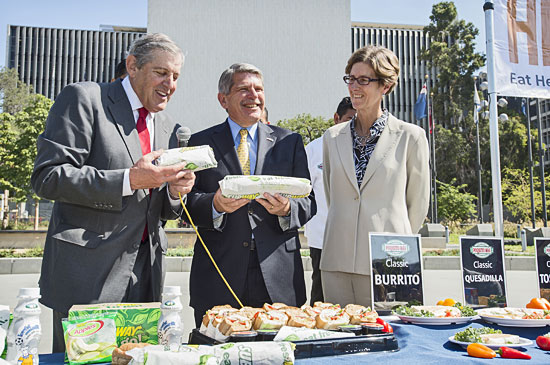
What's for lunch? Mulling choices are, from left, Dr. Jonathan E. Fielding, Supervisor Zev Yaroslavsky, Kim Belshé.
Posted 9/12/13
The next front in jail reform
September 12, 2013
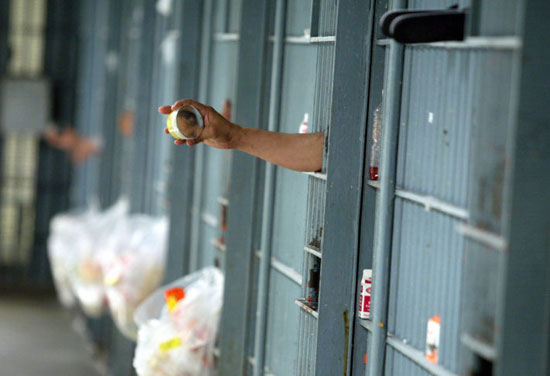
The county is exploring a new stand-alone facility for the incarceration and treatment of mentally ill inmates.
It’s now been two full years since my colleagues on the Board of Supervisors and I appointed a special commission to investigate allegations of widespread brutality by deputies in our county jails. The panel’s creation stands as a clear demonstration of our commitment to ensuring that the constitutional rights of inmates are protected and that members of the Sheriff’s Department, no matter what their rank, are held accountable for transgressions.
Among its findings, released one year ago this month, the Citizens’ Commission on Jail Violence recommended dozens of reforms to restore integrity to the nation’s largest jail system. Although some of those reforms have yet to be implemented—including the hiring of a watchdog Inspector General—measurable improvements are taking root.
But the job’s not nearly done. This is especially true when it comes to a big slice of the jail population that poses a uniquely difficult challenge for the county—the more than 2,000 inmates coping with mental health issues. In an environment of control and conformity, they require a level of individualized care that the system seems unable to consistently provide.
The Sheriff’s Department certainly didn’t ask for its jails to be our mental hospitals of last resort when state mental health dollars and facilities began disappearing decades ago. Clearly, the county’s far-flung lockups were neither designed nor intended for the special needs of these troubled individuals whose mental state likely contributed to the criminality that led to their confinement. But that’s the reality we have faced for years, and it is our obligation to act now with the same sense of urgency we’ve displayed in confronting the problem of deputy violence.
In fact, we’ve been assuring the federal government of our dedication to this mission for the past 11 years, assurances that now apparently have worn thin.
In 2002, the county entered into a Memorandum of Agreement with the Justice Department’s Civil Rights Division, which had concluded that the jail’s staff was engaged in such “abuse and mistreatment of prisoners with mental illnesses” as improperly using physical restraints and providing inadequate facilities and staffing. The Sheriff’s Department, along with the county’s mental health agency, agreed to fix the failings and cooperate in bi-annual federal inspections to ensure that inmates’ constitutional rights were not being violated.
But last week, U.S. Justice Department officials notified the county that they were opening a civil investigation into the allegations of excessive force and undertaking a new “assessment” of the mental health agreement. In a letter to Chief Executive Officer William T Fujioka and Sheriff Baca, justice officials acknowledged the county’s progress in this latter area, but stated bluntly that “significant problems remain.” They cited, among other things, the growing number of inmates with serious mental illnesses who are being housed in “obsolete and dilapidated conditions at Men’s Central Jail” and an increase this year in jail suicides.
I fully agree that the current conditions for mentally ill inmates inside the archaic and depressing central jail are unacceptable—as do my colleagues. In May, acting on a motion I authored, the board voted to take the first steps in the possible construction of an Integrated Treatment Center, which would house all mentally ill inmates and provide care consistent with the federal Civil Rights of Institutionalized Persons Act.
Our action, which represents a potential investment in jail reform for the mentally ill of well over $1 billion, should clearly signal to federal officials our desire to get this right.
I know there are some who’ll see the federal government’s stepped-up scrutiny of our jail system as an intrusion into our local affairs, usurping our sounder, closer-to-the-ground judgment. I disagree. I believe the federal government’s concerns will generate an important public conversation about what needs to be done so the county can move forward without potential federal litigation to force our compliance.
And that conversation could not come at a more crucial time, as our bursting jail system confronts unprecedented pressures because of state legislation AB 109, which has crammed thousands of new inmates into county cells, inmates whose crimes used to land them in state prison.
I also know that the mental health challenges of our inmates do not generate a great deal of concern among a general public that is more concerned about the safety of their neighborhoods. But these are not mutually exclusive goals. Studies show that recidivism drops among mentally ill/dually-diagnosed inmates who receive intensive treatment.
Our system of constitutional government requires that we humanely treat those we place behind bars. But providing adequate mental health treatment to the thousands of inmates in our county jail should also be embraced as a matter of enlightened self-interest.
Posted 9/12/13
A greener future opens up
September 12, 2013
For decades, it has been just another big, concrete L.A. channel, a place known mainly for the unfortunate passersby who have had to be rescued there during winter rains.
But the hardworking Pacoima Wash has been getting a makeover lately, and this week, the Board of Supervisors approved the finishing touches for a 4.75-acre park that will give yet another neighborhood along the tributaries and banks of the Los Angeles River a welcome sliver of green.
“I think it’s going to be good,” said Bertha Macias, a stay-at-home mom in San Fernando on Tuesday as her 4 year old, Benjamin, ran back and forth between the fence and the walkway of her tiny front yard a block from the soon-to-be-opened Pacoima Wash Eighth Street Park.
A mother of three, Macias said her dense neighborhood has far too little open space for the number of children who live there. “I think it will be good for the kids to go to in the afternoons after school,” she said in Spanish. “They’ll watch less television if they can go to a park.”
Due to open in early 2014, the park, which runs between Eighth Street and Foothill Boulevard in the City of San Fernando, marks yet another bit of progress, both for its community and for the long-term movement to re-green the Los Angeles River and its various branches in L.A..
Constructed in the 1940s as a 10-mile-long flood control channel, the Pacoima Wash is a tributary of the Tujunga Wash, which in turn is a tributary of the Los Angeles River. When it rains, its industry-lined banks typically fill with trash and polluted runoff.
Historically, it has been viewed as a purely utilitarian conduit for inland water, and it has been fenced off from the dense, park-starved communities that abut it, dividing them like a freeway. But in 2005, the Mountains Recreation and Conservation Authority acquired several parcels of land along the channel. And in 2008, with the help of a Los Angeles County Department of Public Health grant, a coalition led by the grassroots environmental nonprofit Pacoima Beautiful launched an initiative to reimagine the wash as a place that might not only do a better job of filtering storm water, but also double as an urban greenbelt.
“These communities are, in a lot of ways, park-poor and in need of nature and green space,” said Ana Petrlic, deputy chief of urban projects and watershed planning for MRCA. “And bringing nature to the city is a primary goal of MRCA.”
Indeed, according to Pacoima Beautiful, the community of Pacoima alone has only about a quarter of the park space it should have under the City of Los Angeles’ general plan standards. Meanwhile, one in four residents suffers from heart disease and 29% of the young people are obese.
The MRCA acreage has been combined with land owned by the Los Angeles County Flood Control District to create the first of what MRCA envisions as a series of parks along the wash. Nearly complete, the Pacoima Wash Eighth Street Park, designed by the Los Angeles environmental design firm Blue Green, will feature a small loop trail, a pair of quaint bridges, an arbor for shade and some picnic tables and benches.
“There are great views of the mountains and the Angeles National Forest,” said Petrlic, “and native plants for habitat for the local wildlife.” Built into the park’s design is a system to detain and treat storm water runoff, which will enter the site underneath two small circular plazas—one at Eighth Street, the other at Bromont Avenue—that are equipped with underground filters to catch trash. From there, the water will flow into a newly constructed creek bed that runs parallel to the wash, where it will be further cleansed of pollutants.
“And,” Petrlic said, “that’s all before the water actually reaches the wash.”
This week, the Los Angeles County Supervisors voted to take the greening effort up a notch. They approved a $100,000 grant from Third District park funds to add about 150 new trees to make the now spare-looking space a bit more inviting.
“This is a good thing,” said Manuel Franco of Pacoima, an MRCA worker, as he checked sprinkler heads Tuesday along the greenbelt. “Good for this area. Good for families.”
Posted 9/12/13
No bouncing in the park
September 6, 2013

Exxopolis as it starts to rise in the Civic Center, creating a temporary, inflatable, walk-though world.
“It lives!” exclaimed Christine Breihan as air began to fill Exxopolis—the city-like, inflated art installation that opens to the public this Saturday in Grand Park.
Exxopolis arrived in a box truck Thursday morning, and Breihan and her confederates began setting up immediately, a bit behind schedule after a forklift had to be located at the last minute. Deflated, the exhibit only took up half of the truck, but after being rolled out and positioned, the grey, blue, green and red polyvinyl spanned 175 feet by 95 feet. And as it rose, the installation’s largest dome soared 23 feet into the air.
The fanciful, portable city is making its Los Angeles debut, with the public invited to stroll, free of charge, through its translucent, color-filled interiors over the course of the next two weekends. It is the brainchild of artist Alan Parkinson, whose Nottingham, England-based Architects of Air studio creates giant inflatables called “luminaria” and sends them out into the world on a mission to inspire wonder. Their work began more than two decades ago, growing out of a theatre project for audiences with disabilities. The fully accessible creations aim to attract the widest possible audiences; 500 of them have been displayed in 37 countries since 1992.
But before Exxopolis can work its magic, there’s plenty of advance work to get it off the ground.
Just ask Shanti Freed, the Exxopolis exhibition manager in charge of installing, managing and tearing down the structure after each day’s exhibition.
“There are a lot of floating variables,” Freed said. “It takes a good, long, steady day to set it up and make sure it is all laid out and ballasted correctly.”
Exxopolis requires 32,500 pounds of ballast just to hold it down. Concrete cones and drums are arranged like tent stakes along the perimeter and in gaps between the structure’s undulations. Inflating is the easy part; that only takes about 20 minutes.
Freed’s No. 1 consideration is making sure the 80 or so people who will be in the exhibit at any given time are safe. Staff from the Music Center, which manages Grand Park, will be trained to ensure guests follow rules, which include no running, jumping or sliding.
“The only thing it has in common with a bouncy castle is that it’s inflated,” Freed said of the artwork. “Anyone under the age of 16 must be with a parent; you have to be respectful of that space.”
Her biggest enemy is weather. Last year in Michigan, people were touring when tornado sirens blared. “It was the fastest evacuation I ever did,” Freed said. Trees were uprooted just 2 blocks away and, when Freed emerged from an underground storm shelter, three inches of rain had soaked everything.
Freed said L.A.’s heat shouldn’t pose any difficulties. While it may not be as cold as an office building, massive air conditioners pump air constantly, keeping the interior a few degrees cooler than outside.
The bubble shaped buildings, which are grey on the outside with patches of color where light enters and is reflected, are a striking temporary addition to the park’s green lawn across from City Hall. But things really get interesting inside.
“It’s like a kaleidoscope rainbow, but with no hard edges,” Freed said. “Everything is curved,”
Exxopolis’ L.A. visit comes as part of a U.S. tour. (Next stop: Shreveport, Louisiana.) It will be open to the public on the next two weekends, September 7 through September 8 and September 13 through September 15. People can tour it from 10 a.m. to 6 p.m. each day. The free exhibit has already generated a lot of interest, with advance reservations completely filling up. However, those reservations only comprise half of the possible slots, so walk-ups will be taken on a first come, first served basis. The wheelchair-accessible exhibit is open to all ages.
The experience even comes with a soundtrack, of sorts. The Music Center’s senior director for programming, Barbara Leonard, has arranged for 80 performances called “Random Acts of World Culture,” which will be staged at various places during the exhibition. Most will take place in a large dome called the Cupola, a cathedral-inspired space with plastic “stained glass” windows. Performances will range from individual artists to a septet, with musical styles that span the globe. It is the first time that live music has been integrated into one of the inflatable installations.
“I am very aware of the vision of Grand Park—‘the park for everyone,’ ” Leonard said. “We put the focus on 77 cultures that are a part of our city’s history.”
Leonard met Parkinson in 1994 at a conference, and toured several of his exhibits in other cities. Impressed, she tucked away the idea of bringing a luminarium to Los Angeles someday. When Grand Park opened, the opportunity presented itself. Thursday, she was giddy to see the structure take shape at last.
“Exxopolis is its own little city in my mind,” Leonard said. “We want to make sure the space and the performances have a harmony, have a beauty.”
Posted 9/6/13
Rising river lifts neighborhood, too
September 6, 2013

Chief Ranger Fernando Gomez orchestrates a "community paddle." Photos/Grove Pashley, LA River Kayak Safari
It was still weeks before kayakers would start journeying down a lush stretch of the Los Angeles River, but boosters of the summer-long pilot program could feel the resentment building.
Residents of Elysian Valley were worried that interlopers would start flocking to—and disrespecting—their diverse, working-class neighborhood along the river. Some wary families were still nursing hurts going back generations, when people were relocated to “Frogtown” after being forced from nearby Chavez Ravine to make way for the Brooklyn Dodgers’ new home.
“There are some long memories out there,” said artist Steven Appleton, chairman of the Elysian Valley Riverside Neighborhood Council and an advocate of the escalating efforts to remake the L.A. River. “A perception was developing that a lot of people from outside the area were going to take advantage of them.”
So Appleton donned another hat. He and his partner, Grove Pashley, quickly created a kayak company and began working with the Mountains Recreation and Conservation Authority to build a local constituency for the new Los Angeles River Recreation Zone—a brief, closely-watched collaboration that ended on Labor Day but is winning praise as a model of neighborhood engagement for the future.
News coverage of the pilot program has mostly focused on the strange yet appealing sight of 3,000-plus kayakers who, between Memorial Day and last Monday, worked their way down a 2.5-mile section of the river in the Glendale Narrows area. There, the bottom is coated in silt and rocks, unlike other sections of the 51-mile route, where concrete is the dominant feature. Paddlers included everyone from Los Angeles Mayor Eric Garcetti and County Supervisor Zev Yaroslavsky to veteran thrill seekers and upstart adventurers.
But what’s proven especially gratifying to organizers is the less heralded success of their strategy to get buy-in from Elysian Valley residents.
“We told them, ‘We want you to feel comfortable. We’re not excluding you. We’re including you. ’ It was my job to make sure they felt comfortable and welcomed,” said MRCA Chief Ranger Fernando Gomez.
Among other things, Gomez said, the MRCA, which managed the project on behalf of the City of Los Angeles, increased the number of rangers in the area and told them to enforce such park rules as no overnight camping, drinking or smoking. This quickly gave residents a heightened sense of security in a neighborhood with an engrained gang history. At night, Gomez said, he saw entire families—including a pregnant mom, her husband, son and family dog—walking along the riverbank’s bike path.
“That’s something I never would have seen 10 or 15 years ago. Back then, if people were out, they were up to no good,” said Gomez, who patrolled the area as a rookie ranger. “These families have stepped up and said: ‘This is our backyard.’ ”
Another turning point came when Appleton’s company started to organize “community paddle” evenings for locals, many of whom couldn’t afford the kayak tours ranging in price from $55 to $65, offered by Appleton and a competing company. In all, there were three events, which took place between 4 p.m. and 7 p.m. The final one drew a crowd of 70 residents.
Appleton said one of his best memories of those evenings was of a woman who’d lived along the river her entire life but had never ventured into the water, not even as a kid. “It was on her bucket list,” Appleton said. Although she tumbled five times into the calm and shallow waters in front of Marsh Park, she was having such a good time that, unlike other residents, she wouldn’t relinquish her boat.
“It was occupied the entire three hours,” Appleton recalled admiringly. “She just wouldn’t get out.”
“Initially people in the community were skeptical” of the recreation zone, said Appleton, who began canoeing as a youngster in Michigan. “But those events really helped turn things around.”
Ranger Gomez was more effusive: “The community was ecstatic about it.”
Come next summer, river advocates hope the Glendale Narrows recreation zone will be back and embraced by the community—along with some changes for the next wave of kayakers.
Among other things, Gomez said, it would be helpful to have a second exit along the 2.5 mile zone so novice kayakers, weary from paddling or navigating rocks, can get out sooner. What’s more, he said he’d recommend removing some rocks in difficult passages to create “a little alley or lane that doesn’t alter the river in any shape or form” so frustrated kayakers don’t have to work so hard. “For a quarter of a mile, I don’t think the world would end downstream.”
Like Appleton, the ranger of 20 years has a memory that he also says he’ll treasure of the recreation zone’s inaugural season. His is of a young boy, around 12, who works as a “junior ranger” and is always quiet— “just a follower,” in the words of one MRCA colleague.
The youngster was the last down to the water. When he got into the boat, Gomez said, “he clenched his teeth and was literally started shaking with fear. I said, ‘Hi Buddy. I’m going to help you out. I’m going to teach you how to paddle—right, left, right, left. Not only did he learn about the river, he learned the skill of kayaking. By the end of the trip, he was racing other kids.”
Gomez paused at the memory. “I’m getting chills thinking about it,” he said.

Elysian Valley activist and entrepreneur Steven Appleton takes some neighborhood youngsters for a paddle.
Posted 9/6/13
Dog law gets some extra bite
September 6, 2013

Dogs that attack horses, cows and other livestock will soon be designated as "potentially dangerous."
Spurred by the recent fatal pit bull attack on a 63-year Antelope Valley woman, the Los Angeles County Board of Supervisors on Tuesday voted to make it easier to take action against lethal canines by broadening the legal definition of a “potentially dangerous dog.”
The new definition, particularly significant in rural parts of the county, allows serious attacks on livestock—including horses, cows, alpacas, chickens and rabbits—to qualify a dog as “potentially dangerous” under county animal control laws. The current ordinance authorizes that classification only if the dog has moderately injured a person, forced a person to take defensive action more than once in 36 months or severely injured or killed a dog or a cat.
Restrictions for a potentially dangerous dog can range from requiring the animal to be leashed and muzzled in public to mandating that the owner take out liability insurance and keep the dog inside or in a secure, county-inspected yard.
Animal control officers contend that the amended criteria might have made a life-and-death difference in the case of Pamela Devitt, who was jogging in the Antelope Valley community of Littlerock in May when four pit bulls attacked her on the street. Fatally mauled, Devitt died in an ambulance on the way to the hospital. The owner, 29-year-old Alex Jackson, is in custody and facing homicide charges.
Of the eight dogs confiscated from his home, four were euthanized, said Animal Care and Control Director Marcia Mayeda. The other four—two pit bulls, a Labrador-collie mix and an Australian heeler mix—were taken in by a rescue group and placed in homes.
“We’d had complaints about these dogs and had been out to the house twice,” Mayeda said. But the dogs were not in sight, she said, and the owner had insisted the complaints involved strays, not his dogs.
Just three weeks before Devitt’s death, however, a woman had complained that the pit bulls had come after her and her horse, Mayeda said. She said the complaint was serious enough that the department had asked her to complete a sworn affidavit.
“We were still waiting for her statement when the attack on Mrs. Devitt happened,” Mayeda said. “Had we had this law on the books, we could have just declared those dogs potentially dangerous and restricted them.”
The new definition is part of an intensified county focus on the problem of dangerous dogs. About one call in ten to the Department of Animal Care and Control—about 10,000 annually—involve dogs that are aggressive and biting. Packs of abandoned dogs have become an increasingly vexing issue in the high desert and other semi-rural areas. Earlier this year, the Board of Supervisors approved $3.5 million in new spending on animal control.
So far this year, Mayeda said, the county has conducted more than 400 hearings to determine whether a dog is vicious or potentially dangerous. Most of those cases, she said, ended with the dog being restricted. More than half have involved pit bulls.
Posted 9/6/13
Carbs gone wild at the fair
September 5, 2013
It was 100 degrees at the Los Angeles County Fair in Pomona, but at Chicken Charlie’s food stand, Nelly Alvarez was hustling to keep up with demand for this year’s signature dish.
“Yep, it’s a half-pound double cheeseburger between two Krispy Kreme donuts—really,” Alvarez explained to one wide-eyed taker after another. “I hear they’re pretty good!”
Privately, however, Alvarez confessed that she actually hasn’t tried Chicken Charlie’s cheesy, meaty, sugary, gooey new 1,160-calorie item, which this week joined the fair vendor’s menu of deep-fried avocados, deep-fried pickles, deep-fried Oreos, deep-fried Kool-Aid, Krispy Kreme Sloppy Joes and other diet-busting fare. After seven years working at fair booths, she said, she now brown-bags it at her lunch breaks.
“I bring a lot of fruit, a lot of water,” she laughed, looking around to make sure no potential customers were listening. “I brought a salad today.”
Few displays evoke more mixed feelings in food- and health-obsessed Southern California than the deep-fried gluttony of the Los Angeles County Fair. In L.A., where food trucks compete with high-end juice bars, and bacon-wrapped everything vies with the pursuit of the perfect kale salad, the fair menu never fails to offer an over-the-top serving of amusement, rebellion and carbs gone wild.
“I try to be good. I try!” said Marie Thomas of Carson, wandering through a haze of Texas barbecue smoke, kettle corn and cotton candy. “But once a year? C’mon.”
After all, she pointed out, she shopped hard at the fair, which theoretically might burn off some extra calories. “So right now, I’m looking for something cheesy, something greasy and something fried.”
Los Angeles County Director of Public Health Dr. Jonathan E. Fielding, whose department has been part of a nationwide anti-obesity effort, says there’s nothing wrong with the occasional splurge. Everything in moderation—that’s essentially the theme of the county’s Choose Less, Weigh Less campaign.
“I can’t say not to go to the fair,” Fielding says, noting that he rarely misses. In fact, he said, his department plans to staff a booth there for County Day later this week.
“But I’m in favor of choice, and sometimes the choice at the fair isn’t as broad as it is in other places.” Indeed, asked how to eat at the fair and remain healthy, Fielding was hard-pressed: “Well,” he joked, “I think at one point I saw corn.”
Fair spokeswoman Renee Hernandez says some healthy food does, in fact, co-exist with the traditional extreme fair food.
“Cardinale’s Wood Fired Pizza has a pizza salad, which is a bed of romaine and mixed greens with healthy pizza toppings,” she says. “And there are chicken and shrimp kebabs.”
And, she notes, there’s Terri’s Berries, the Encinitas-based fruit stand that has been at the fair for decades.
“We get a lot of people who are happy to find us,” said Elodie Crutchfield, proffering whole fruit and baskets of berries, some of which were, shockingly, not even dipped in chocolate. “I know the ceviche stand has a mango cup, but that’s the only other healthy fruit option I know of here.”
DPH Director Fielding noted that eating something nutritious before or after a trip to the fair might work for some people. “I think you just have to choose carefully and not be easily seduced by what looks most appetizing on an empty stomach.”
But sometimes the pull is just too overwhelming.
“This looks amazing!” cried 13-year-old Daniel Chinn as donut glaze oozed onto the bright yellow cheese of his Krispy Kreme burger.
Afterward, the youngster was less enthusiastic.
“It was good,” he said, slumped at the lunch table and wearing a wan expression. “But now I feel horrible.”
Posted 9/5/13




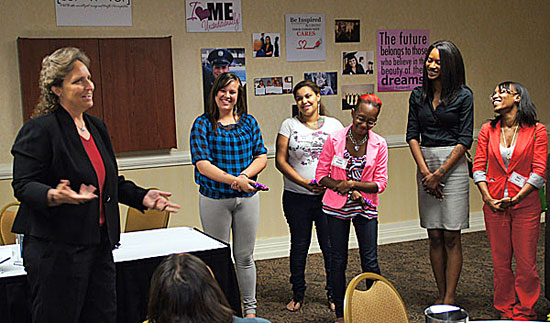
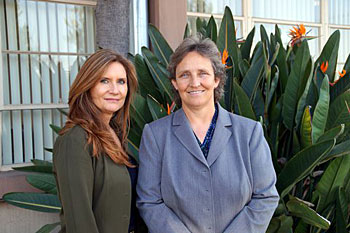
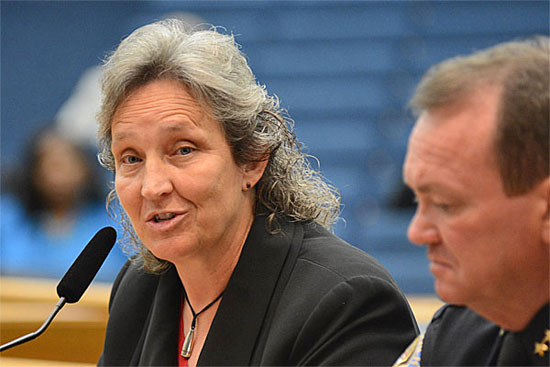
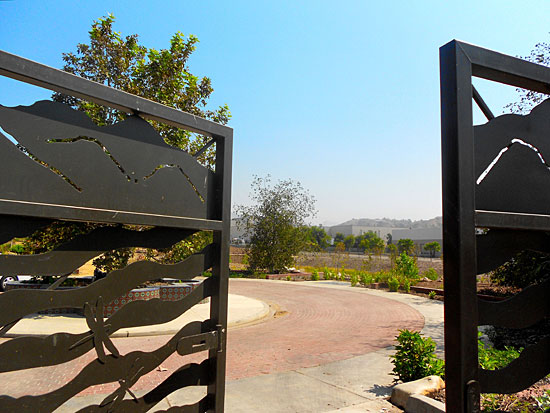

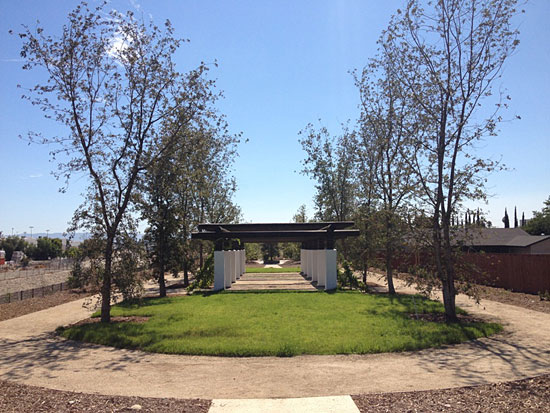









 Check for the latest closure information
Check for the latest closure information








